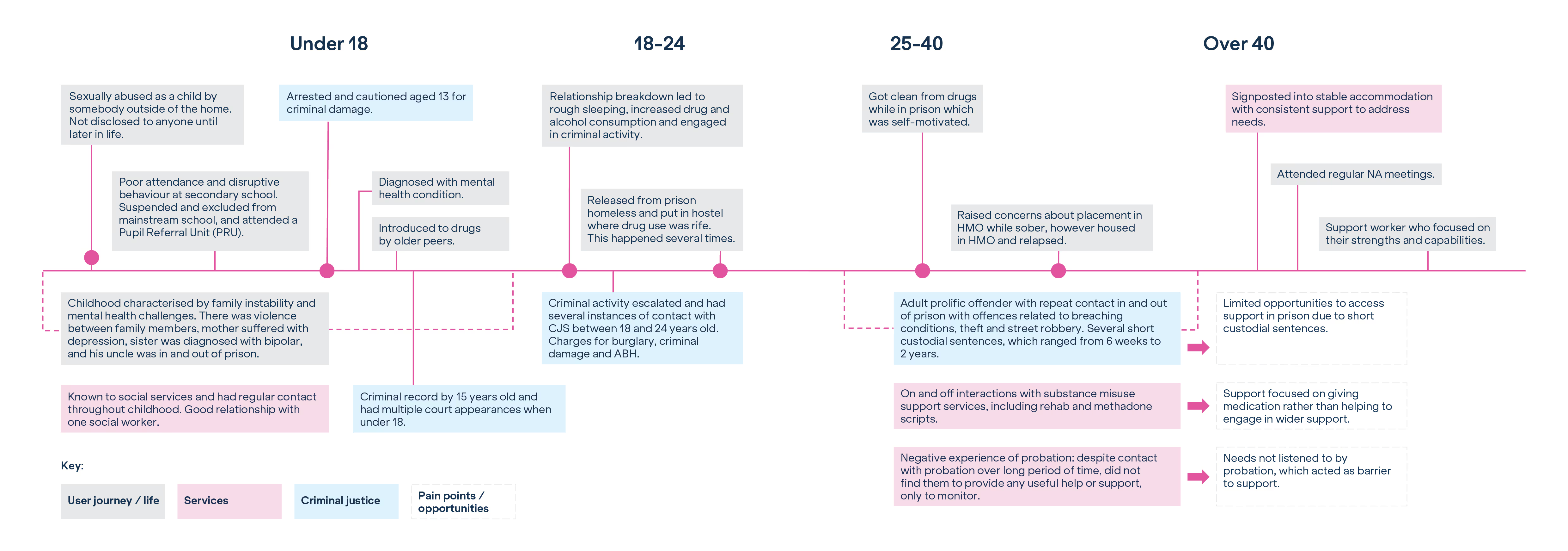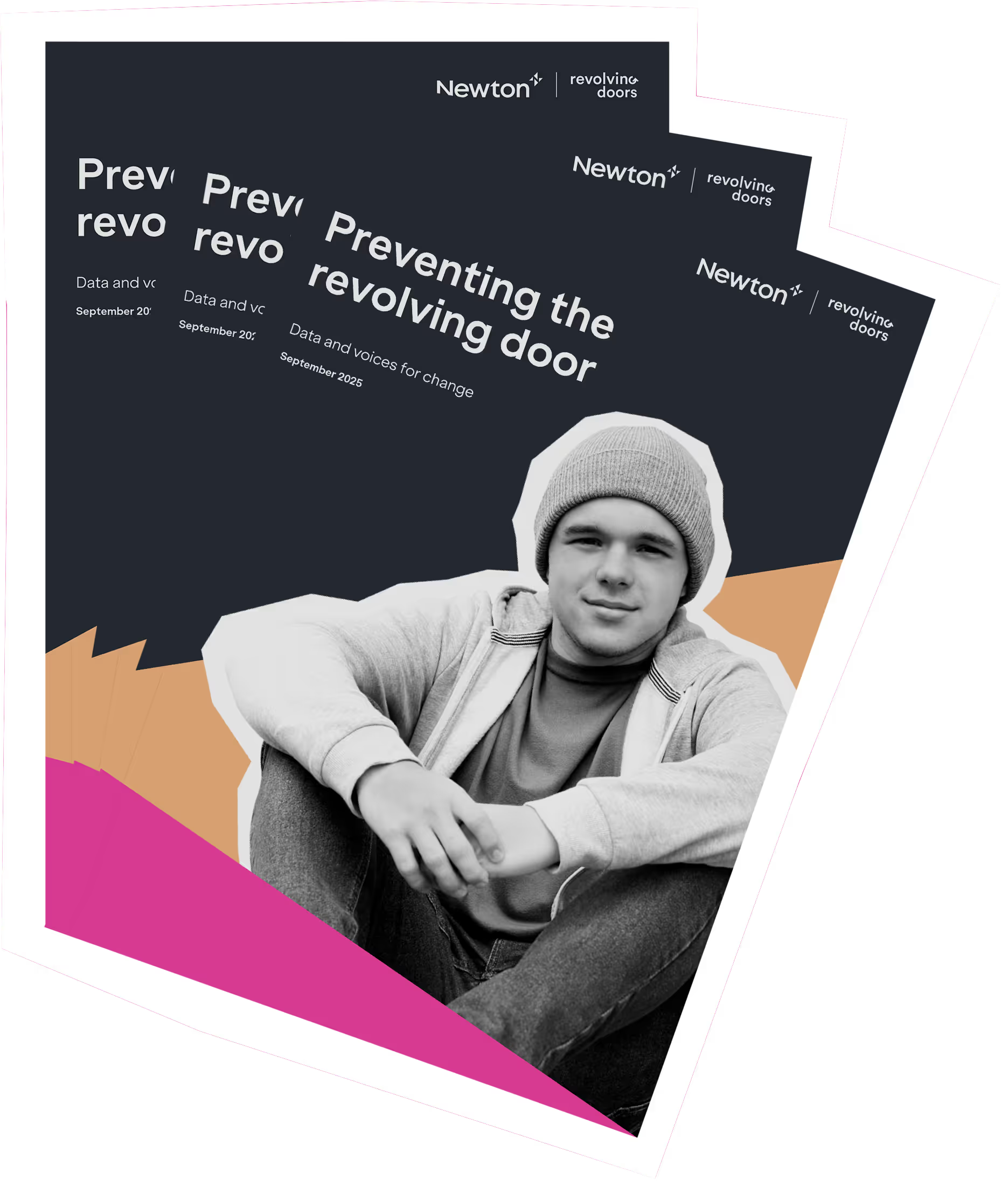User journeys
Research revealed clear patterns in the lives of people caught in the revolving door of crime, reflected both in the 20 interviews and in service data.


Patterns of experience
While many share common experiences — like school exclusion or early encounters with social services — individual circumstances vary widely. Some grew up in loving homes and did well at school, highlighting that there is no single “pathway” into the revolving door. Once engaged with public services, a recurring theme is transactional, low-impact support that often escalates rather than resolves issues, leaving core needs unmet. Positive interactions do occur, particularly when services recognise individual strengths and provide holistic, trauma-informed support. These consistent patterns offer a blueprint for person-centred, relational interventions, showing how effective support can break cycles and steer people towards lasting positive outcomes.


User stories
Here are two real criminal justice journeys drawn from reference data up to November 2024. These findings demonstrate the power of combining lived experience with data-driven analysis, showing how much can be learned about the revolving door of offending.


Person 1, (Male 19)
This person is linked to 19 crime reference numbers between Oct 2022 and Oct 2024.
These offences span assault with injury, assault without injury, harassment, malicious communications, criminal damage, theft and threats to kill, and they are known as both suspect and victim across these offences, with their age at the time of the first offence being 16. All offences happened in the same city.
Across this period, they were known to Police, Children’s Social Care (CSC), and Youth Justice services, with six intersecting risk factors: substance misuse, trauma, mental health, behavioural issues, neurodiversity, and housing challenges. They cycled through multiple CSC plans, including Early Help, Child Protection, Looked After Children, and Child in Need - and received two youth conditional cautions.
While dates of interventions are not fully available, the pattern of offences alongside engagement with statutory services suggests escalating behaviour, with interventions adjusting in response. This highlights the complexity of managing support for individuals in the revolving door and the need for coordinated, targeted approaches.
Victim
Suspect
October 2022
Theft in a Public Place
October 2022
Attempted Criminal Damage
October 2022
Theft in a Public Place
October 2022
Attempted Criminal Damage
November 2022
Threats to kill
January 2023
Assault with injury
February 2023
Assault with injury
June 2023
Assault with injury
September 2023
Generalised Theft & ABH
November 2023
ABH, Malicious / Harassing Messages
November 2023
ABH, Assault without injury, Malicious / Harassing Messages
December 2023
Violence without injury, Online Harassment
December 2023
Assault without injury
August 2024
Poisoning
September 2024
Harassment
October 2024
Death Threats
Person 2, (Male 20)
This person is linked to 27 crime reference numbers between Oct 2022 and Nov 2024.
These offences span assault with injury, assault without injury, assault of an emergency worker, harassment, malicious communications, criminal damage and burglary. They are known as both suspect and victim across these offences, with their age at the time of the first offence being 17. Offences were predominantly in one area from October 2022 to March 2023, then from June 2024 onwards offences were liked to a different area.
They are known in Police, CSC, and YJ data sets, with a combination of seven risk categories: substance misuse, trauma, mental health, behavioural, discrimination, education gaps and housing issues.
While there are no dates for the above list of interventions in the data available, the offence list, combined with the information about their pattern of engagement with statutory services, suggests that there was an escalation in the individual’s behaviour which was linked to them being taken into care. It is possible that this moved the individual from one area to another, where they continued to get into trouble, experienced violent offences committed against them, and consequently led to an increase in the seriousness of their offending. The individual may have become involved with other people, leading to a change in type of offending.
Victim
Suspect
October 2022
Attempted Assault without injury, Theft in a Public Place
October 2022
Residential Criminal Damage, ABH (3 Counts)
February 2023
Multiple ABH, Assault without injury
June 2023
Burglary
September 2023
Generalised Theft & ABH
January 2024
Burglary
February 2024
GBH
March 2024
Burglary
June 2024
Malicious Communications
June 2024
Harassment / Intimidation, ABH
October 2024
ABH
June 2024
ABH, Race / Religiously Aggravated Harassment, Residential Criminal Damage
Useful links

Findings from 20 in-depth interviews with people who have lived through the revolving door of crisis and crime.

Advanced analysis reveals the patterns, unmet needs, and risks driving the revolving door cohort, showing how data can inform smarter, preventative interventions.

Combining detailed reference data with local socio-economic information revealed how the size, shape, and needs of the revolving door cohort vary across England.
Read more about the research process, key findings, and expert recommendations.
